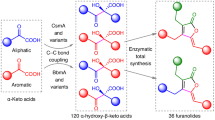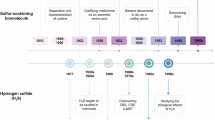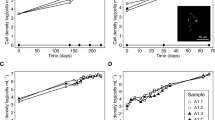Abstract
Carbon–sulfur bond-forming reactions in natural product biosynthesis largely involve Lewis acid/base chemistry with relatively few examples catalysed by radical S-adenosyl-l-methionine (SAM) enzymes. The latter have been limited to radical-mediated sulfur insertion into carbon–hydrogen bonds with the sulfur atom originating from a sacrificial auxiliary iron–sulfur cluster. Here we show that the radical SAM enzyme AbmM encoded in the albomycin biosynthetic gene cluster catalyses a sulfur-for-oxygen swapping reaction, transforming the furanose ring of cytidine 5′-diphosphate to a thiofuranose moiety that is essential for the antibacterial activity of albomycin δ2. Thus, in addition to its canonical function of mediating the reductive cleavage of SAM, the radical SAM catalytic cluster of AbmM appears to play a role in providing the sulfur introduced during the AbmM-catalysed reaction. These discoveries not only establish the origin of the thiofuranose core in albomycin δ2 but, more importantly, also emphasize the functional diversity of radical SAM catalysis.

This is a preview of subscription content, access via your institution
Access options
Access Nature and 54 other Nature Portfolio journals
Get Nature+, our best-value online-access subscription
$32.99 / 30 days
cancel any time
Subscribe to this journal
Receive 12 digital issues and online access to articles
$119.00 per year
only $9.92 per issue
Buy this article
- Purchase on SpringerLink
- Instant access to full article PDF
Prices may be subject to local taxes which are calculated during checkout






Similar content being viewed by others
Data availability
The data that support the findings of this study are available within the article and its Supplementary Information. The coordinates and the structure factor amplitudes for AbmM have been deposited at the Protein Data Bank with accession code 8WM2. Source data are provided with this paper.
References
Gause, G. F. Recent studies on albomycin, a new antibiotic. Br. Med. J. 12, 1177–1179 (1955).
Stapley, E. O. & Ormond, R. E. Similarity of albomycin and grisein. Science 125, 587–589 (1957).
Benz, G. Enzymatische Spaltung der Desferriform der Albomycine δ1, δ2. Liebigs Ann. Chem. 1984, 1399–1407 (1984).
Benz, G. et al. Absolute Konfiguration der Desferriform der Albomycine. Liebigs Ann. Chem. 1984, 1408–1423 (1984).
Lin, Z. et al. Total synthesis and antimicrobial evaluation of natural albomycins against clinical pathogens. Nat. Commun. 9, 3445 (2018).
Stefanska, A. L., Fulston, M., Houge-Frydrych, C. S. V., Jones, J. J. & Warr, S. R. A potent seryl tRNA synthetase inhibitor SB-217452 isolated from a Streptomyces species. J. Antibiot. 53, 1346–1353 (2000).
Clarke, T. E., Braun, V., Winkelmann, G., Tari, L. W. & Vogel, H. J. X-ray crystallographic structures of the Escherichia coli periplasmic protein FhuD bound to hydroxamate-type siderophores and the antibiotic albomycin. J. Biol. Chem. 277, 13966–13972 (2002).
Paulsen, H., Brieden, M. & Benz, G. Synthese des Sauersstoffanalogons der Desferriform von δ1-Albomycin. Liebigs Ann. Chem. 1987, 565–575 (1987).
Zeng, Y. et al. Biosynthesis of albomycin δ2 provides a template for assembling siderophore and aminoacyl-tRNA synthetase inhibitor conjugates. ACS Chem. Biol. 7, 1565–1575 (2012).
Ushimaru, R. & Liu, H. W. Biosynthetic origin of the atypical stereochemistry in the thioheptose core of albomycin nucleoside antibiotics. J. Am. Chem. Soc. 141, 2211–2214 (2019).
Ushimaru, R., Chen, Z., Zhao, H., Fan, P.-h. & Liu, H.-w. Identification of the enzymes mediating the maturation of the seryl-tRNA synthetase inhibitor SB-217452 during the biosynthesis of albomycins. Angew. Chem. Int. Ed. 59, 3558–3562 (2020).
Lanz, N. D. & Booker, S. J. Auxiliary iron–sulfur cofactors in radical SAM enzymes. Biochim. Biophys. Acta 1853, 1316–1334 (2015).
Grell, T. A., Goldman, P. J. & Drennan, C. L. SAPSM and twitch domains in S-adenosylmethionine (SAM) radical enzymes. J. Biol. Chem. 290, 3964–3971 (2015).
Oberg, N., Precord, T. W., Mitchell, D. A. & Gerlt, J. A. RadicalSAM.org: a resource to interpret sequence-function space and discover new radical SAM enzyme chemistry. ACS Bio Med. Chem. Au 2, 22–35 (2022).
Dunbar, K. L., Scharf, D. H., Litomska, A. & Hertweck, C. Enzymatic carbon–sulfur bond formation in natural product biosynthesis. Chem. Rev. 117, 5521–5577 (2017).
Broderick, J. B., Duffus, B. R., Duschene, K. S. & Shepard, E. M. Radical S-adenosylmethionine enzymes. Chem. Rev. 114, 4229–4317 (2014).
Sasaki, E. et al. Co-opting sulphur-carrier proteins from primary metabolic pathways for 2-thiosugar biosynthesis. Nature 510, 427–431 (2014).
Ruszczycky, M. W. & Liu, H.-w. Initiation, propagation and termination in the chemistry of radical SAM enzymes. Biochemistry 63, 3161–3183 (2024).
Roche, B. et al. Iron/sulfur proteins biogenesis in prokaryotes: formation, regulation and diversity. Biochim. Biophys. Acta 1827, 923–937 (2013).
Boyd, E. S. et al. Interplay between oxygen and Fe–S cluster biogenesis: insights from the Suf pathway. Biochemistry 53, 5834–5847 (2014).
Outten, F. W. Recent advances in the Suf Fe–S cluster biogenesis pathway: beyond the Proteobacteria. Biochim. Biophys. Acta Mol. Cell. Res. 1853, 1464–1469 (2015).
McCarthy, E. L. & Booker, S. J. Destruction and reformation of an iron–sulfur cluster during catalysis by lipoyl synthase. Science 358, 373–377 (2017).
Guianvarc’h, D., Florentin, D., Tse Sum Bui, B., Nunzi, F. & Marquet, A. Biotin synthase, a new member of the family of enzymes which uses S-adenosylmethionine as a source of deoxyadenosyl radical. Biochem. Biophys. Res. Commun. 236, 402–406 (1997).
Berkovitch, F., Nicolet, Y., Wan, J. T., Jarrett, J. T. & Drennan, C. L. Crystal structure of biotin synthase, an S-adenosylmethionine-dependent radical enzyme. Science 303, 76–79 (2004).
Ollagnier-de Choudens, S. & Fontecave, M. The lipoate synthase from Escherichia coli is an iron–sulfur protein. FEBS Lett. 453, 25–28 (1999).
Busby, R. W., Schelvis, J. P. M., Yu, D. S., Babcock, G. T. & Marletta, M. A. Lipoic acid biosynthesis: LipA is an iron–sulfur protein. J. Am. Chem. Soc. 121, 4706–4707 (1999).
McLaughlin, M. I. et al. Crystallographic snapshots of sulfur insertion by lipoyl synthase. Proc. Natl Acad. Sci. USA 113, 9446–9450 (2016).
Esakova, O. A. et al. Structural basis for tRNA methylthiolation by the radical SAM enzyme MiaB. Nature 597, 566–570 (2021).
Foroubar, F. et al. Two Fe–S clusters catalyze sulfur insertion by radical–SAM methylthiotransferases. Nat. Chem. Biol. 9, 333–338 (2013).
Jumper, J. et al. Highly accurate protein structure prediction with AlphaFold. Nature 596, 583–589 (2021).
Hänzelmann, P. & Schindelin, H. Crystal structure of the S-adenosylmethionine-dependent enzyme MoaA and its implications for molybdenum cofactor deficiency in humans. Proc. Natl Acad. Sci. USA 101, 12870–12875 (2004).
Hänzelmann, P. & Schindelin, H. Binding of 5′-GTP to the C-terminal FeS cluster of the radical S-adenosylmethionine enzyme MoaA provides insights into its mechanism. Proc. Natl Acad. Sci. USA 103, 6829–6834 (2006).
Namkoong, G. & Suess, D. L. M. Cluster-selective 57Fe labeling of a Twitch-domain-containing radical SAM enzyme. Chem. Sci. 14, 7492–7499 (2023).
Maiocco, S. J., Grove, T. L., Booker, S. J. & Elliott, S. J. Electrochemical resolution of the [4Fe–4S] centers of the AdoMet radical enzyme BtrN: evidence of proton coupling and an unusual, low-potential auxiliary cluster. J. Am. Chem. Soc. 137, 8664–8667 (2015).
Zhao, Q., Wang, M., Xu, D., Zhang, Q. & Liu, W. Metabolic coupling of two small-molecule thiols programs the biosynthesis of lincomycin A. Nature 518, 115–119 (2015).
Chen, X. & Li, B. How nature incorporates sulfur and selenium into bioactive natural products. Curr. Opin. Chem. Biol. 76, 102377 (2023).
Steele, A. D., Kiefer, A. F. & Shen, B. The many facets of sulfur incorporation in natural product biosynthesis. Curr. Opin. Chem. Biol. 76, 102366 (2023).
Sambrook, J. & Russell, D. W. Molecular Cloning: A Laboratory Manual 3rd edn (Cold Spring Harbor Laboratory Press, 2001)
Sun, Y. H. et al. Organization of the biosynthetic gene cluster in Streptomyces sp. DSM 4137 for the novel neuroprotectant polyketide meridamycin. Microbiology 152, 3507–3515 (2006).
MacNeil, D. J. et al. Analysis of Streptomyces avermitilis genes required for avermectin biosynthesis utilizing a novel integration vector. Gene 111, 61–68 (1992).
Wilkinson, C. J. et al. Increasing the efficiency of heterologous promoters in actinomycetes. J. Mol. Microbiol. Biotechnol. 4, 417–426 (2002).
Willcott, M. R. MestRe Nova. J. Am. Chem. Soc. 131, 13180–13180 (2009).
Zhang, Y., Werling, U. & Edelmann, W. SLiCE: a novel bacterial cell extract-based DNA cloning method. Nucleic Acids Res. 40, e55 (2012).
Guerrero, F., Ciragan, A. & Iwai, H. Tandem SUMO fusion vectors for improving soluble protein expression and purification. Protein Expr. Purif. 116, 42–49 (2015).
Marblestone, J. G. et al. Comparison of SUMO fusion technology with traditional gene fusion systems: enhanced expression and solubility with SUMO. Protein Sci. 15, 182–189 (2006).
Fish, W. W. Rapid colorimetric micromethod for the quantitation of complexed iron in biological samples. Methods Enzymol. 158, 357–364 (1988).
Beinert, H. Semi-micro methods for analysis of labile sulfide and of labile sulfide plus sulfane sulfur in unusually stable iron–sulfur proteins. Anal. Biochem. 131, 373–378 (1983).
Zheng, L., Cash, V. L., Flint, D. H. & Dean, D. R. Assembly of iron–sulfur clusters: identification of an iscSUA-hscBA-fdx gene cluster from Azotobacter vinelandii. J. Biol. Chem. 273, 13264–13272 (1998).
Petasis, D. T. & Hendrich, M. P. Quantitative interpretation of multifrequency multimode EPR spectra of metal containing proteins, enzymes, and biomimetic complexes. Methods Enzymol. 563, 171–208 (2015).
Münck, E. in Physical Methods in Bioinorganic Chemistry: Spectroscopy and Magnetism (ed. Que, L. Jr) 287–319 (University Science Books, 2000).
Middleton, P., Dickson, D. P. E., Johnson, C. E. & Rush, J. D. Interpretation of the Mössbauer spectra of the four-iron ferredoxin from Bacillus stearothermophilus. Eur. J. Biochem. 88, 135–141 (1978).
Acknowledgements
This work was supported by grants from the National Institutes of Health (GM035906 and GM153203 to H-w.L.; GM125924 to Y.G.), the Welch Foundation (F-1511 to H.-w.L.), the Ministry of Education, Culture, Sports, Science and Technology, Japan (JSPS KAKENHI grant numbers JP20KK0173, JP21K18246 and JP23H00393 to I.A.; JP22H05123, JP23K13847, JP24H01309, 25H02006 and 25K02417 to R.U.), the New Energy and Industrial Technology Development Organization (NEDO; grant number JPNP20011 to I.A.), the Japan Agency for Medical Research and Development (AMED; grant number JP21ak0101164 to I.A.), and the Japan Science and Technology Agency (JST FOREST; grant number JPMJFR2305 to R.U.; JPMJFR226I to T.M.). This work was also supported by funds from the Astellas Foundation, Mochida Memorial Foundation, Naito Foundation, Japan Foundation for Applied Enzymology, Uehara Memorial Foundation and Suzuken Memorial Foundation to R.U. We thank S. Booker at The Pennsylvania State University, D. Dean at Virginia Polytechnic Institute and State University, and Y. Sun at Wuhan University for kindly providing the vectors pSUMO, pDB1282 and pYH7, respectively. We also thank M. Ruszczycky for his critical suggestions during preparation of the paper.
Author information
Authors and Affiliations
Contributions
R.U., Y.G. and H.-w.L. designed the research and wrote the paper. R.U. carried out the genetic experiments. R.U. and Z.Z. conducted the chemical synthesis and in vitro enzyme assays. R.U., T.M. and I.A. performed the crystal structure analysis. Z.Z. prepared the Mössbauer and EPR samples and J.X. carried out the Mössbauer and EPR spectroscopy experiments. Z.Z. performed the selective 34S labelling experiments. All authors analysed and discussed the results.
Corresponding authors
Ethics declarations
Competing interests
The authors declare no competing interests.
Peer review
Peer review information
Nature Catalysis thanks Simone Ciofi-Baffoni and the other, anonymous, reviewer(s) for their contribution to the peer review of this work.
Additional information
Publisher’s note Springer Nature remains neutral with regard to jurisdictional claims in published maps and institutional affiliations.
Extended data
Extended Data Fig. 1 Gene deletion of abmM and analysis of purified AbmM.
(a) LCMS analysis of the culture of the ΔabmM deletion mutant showing extracted ion chromatogram (EIC) traces corresponding to the [M + H]+ signal from albomycin δ2 (1) (m/z = 1046.3). (b) LCMS analysis of the culture of the ΔabmM deletion mutant showing EIC traces corresponding to the [M + H]+ signal from SB-217452 (4) (m/z = 477.1). (c) LCMS analysis of the culture of the ΔabmM strain complemented with abmM showing EIC traces corresponding to the [M + H]+ signal from albomycin δ2 (1) (m/z = 1046.3). (d) LCMS analysis of the culture of the ΔabmM strain complemented with abmM showing EIC traces corresponding to the [M + H]+ signal from SB-217452 (4) (m/z = 477.1). (e) SDS-PAGE of AbmM purification. Lane 1: molecular weight markers; Lane 2: purified N-His6-SUMO-AbmM (48.2 kDa); Lane 3, digestion of N-His6-SUMO-AbmM; Lane 4, purified AbmM without the tag (36.1 kDa). This experiment was repeated independently three times with similar results. (f) UV-vis absorption spectra of AbmM. Solid line, 15 μM as-isolated AbmM; dotted line, 15 μM as-isolated AbmM after treatment with 200 μM sodium dithionite.
Extended Data Fig. 2 Studies of the AbmM reaction.
(a) Detection of l-methionine by LCMS. EIC traces corresponding to the [M + H]+ signal of l-methionine (m/z = 150.0583) are shown. A small amount of l-methionine was detected from the reaction mixture without AbmM or dithionite likely due to nonenzymatic degradation of SAM. (b) LCMS analysis of the AbmM reaction mixture. The [M – H]− signal at m/z 402.0130 arises from CDP (10, calc for C9H14N3O11P2−, 402.0109). The [M – H]− signal at m/z 433.9849 is consistent with the mass of 13 (calc. for C9H14N3O11P2S−, 433.9830). (c) LCMS analysis of the AbmM reaction carried out under different conditions. The analysis was conducted after the incubation mixture was treated with CIP. Three EIC traces (m/z = 276.06, 244.09, and 252.2, corresponding to the [M + H]+ signals from 14, 8, and 5′-deoxyadenosine, respectively) are overlaid. (d) LCMS analysis of the AbmM reaction with different substrates such as cytidine, CMP, CDP and CTP (8-11). Prior to the analysis, the incubation mixture was treated with CIP. Three EIC traces (m/z = 276.06, 244.09, and 252.2, corresponding to the [M + H]+ signals from 14, 8, and 5′-deoxyadenosine, respectively) are overlaid. Other tested compounds, cytidine 2′:3′-cyclic monophosphate (2′:3′-cyclic CMP), cytidine 3′:5′-cyclic monophosphate (3′:5′-cyclic CMP), 2′-deoxycytidine (2′-dC), 2′-deoxycytidine 5′-monophosphate (2′-dCMP), 2′-deoxycytidine 5′-diphosphate (2′-dCDP), deoxycytidine 5′-triphosphate (2′-dCTP), adenosine 5′-diphosphate (ADP), adenosine 5′-triphosphate (ATP), guanosine 5′-diphosphate (GDP), guanosine 5′-triphosphate (GTP), thymidine 5′-diphosphate (TDP), thymidine 5′-triphosphate (TTP), uridine 5′-diphosphate (UDP), and uridine 5′-triphosphate (UTP), were not accepted by AbmM as judged by no formation of 5′-deoxyadenosine (data not shown). (e) HPLC analysis of purified 14.
Extended Data Fig. 3 AbmM product and deuterium labelling experiments.
(a) and (b) LCMS analysis of the AbmM reaction mixture treated with CIP/mBBr or CIP/mBBr/NaBH4. EIC traces corresponding to the [M + H]+ signal from each species are overlaid (m/z 466.14 for 14-bimane and m/z 468.16 for 15). In (b): Bottom trace: ESI-MS analysis of 14-bimane generated from the AbmM product upon treatment with CIP/mBBr (calc for C19H24N5O7S+, 466.1391). Middle trace: ESI-MS analysis of 15 generated from the AbmM product upon treatment with CIP/mBBr/NaBH4 (calc for C19H26N5O7S+, 468.1547). Top trace: ESI-MS analysis of [4′-2H]-15 generated from the AbmM product upon treatment with CIP/mBBr/NaBD4 (calc for C19H25DN5O7S+, 469.1610). (c) ESI-MS analysis of 5′-dA and (d) 14 generated in the AbmM reaction using deuterated CDPs as substrates. The analysis was conducted after the incubation mixture was treated with CIP (5′-dA, calc for C10H14N5O3+, 252.1091; 14, calc for C9H14N3O5S+, 276.0649; [3′-2H]-14, calc for C9H13DN3O5S+, 277.0711; [5′,5′-2H2]-14, calc for C9H12D2N3O5S+, 278.0774). (e) ESI-MS analysis of 14 (calc for C9H14N3O5S+, 276.0649) generated in the AbmM reaction in H218O (52% 18O). The analysis was conducted after the incubation mixture was treated with CIP.
Extended Data Fig. 4 Structural analysis of AbmM.
(a) Overall dimeric structure of AbmM shown in purple. (b) Monomer of AbmM. (c) C-terminal AUX cluster. (d) Overlay of the crystal and predicted structures of AbmM. The predicted structure is shown in grey. (e) The RS cluster binding loops of AbmM (crystal and predicted structures) and MoaA (shown in blue, PDB 2FB3). (f) Distance between the docked RS cluster and AUX cluster in AbmM.
Extended Data Fig. 5 57Fe Mössbauer spectra of selected AbmM samples.
(a) 0.3 mM reconstituted ΔRS-cluster variant; (b) 0.2 mM reconstituted AbmM; (c) 0.3 mM DT-treated ΔRS-cluster variant; (d) 0.2 mM DT-treated AbmM; (e) 0.3 mM 56Fe-PT-AbmM-ΔRS cluster (red) and 0.3 mM 56Fe-PT-57Fe-PT-AbmM-ΔRS cluster (green); (f) 0.15 mM as-isolated 57Fe-AbmM (orange), 0.15 mM 57Fe-PT-AbmM (blue), and 0.15 mM 57Fe-PT-56Fe-AbmM (AUX-labelled) (dark green). The measurement conditions are indicated with external magnetic fields parallel to the γ-radiation. Bars show experimental data with statistical uncertainty of the data (the length of the vertical bars), red solid lines represent overall simulations. Simulation parameters are listed in Extended Data Table 2. The sample of 57Fe-PT-AbmM was prepared by overexpressing AbmM in media enriched with 57Fe and subsequently treated with PT before spectroscopic characterization. The sample of 56Fe-PT-57Fe-PT-AbmM-ΔRS cluster was prepared by overexpressing AbmM ΔRS-cluster variant in media containing natural abundance Fe, followed by treatment of the isolated protein with PT and then reconstitution with 57FeCl3. The resulting sample was further treated with PT. Other combinations such as 56Fe-PT-AbmM-ΔRS cluster were prepared in an analogous manner. The Fe content analysis yielded (Fe/protein monomer) 2.4 for as-isolated AbmM-ΔRS cluster, 2.4 for 56Fe-PT-AbmM-ΔRS cluster, 6.0 for 56Fe-PT-57Fe-AbmM-ΔRS cluster, and 2.7 for 56Fe-PT-57Fe-PT-AbmM-ΔRS cluster.
Extended Data Fig. 6 34S labelling experiments.
(a) ESI-MS spectrum of S-(bimane)2 obtained by reacting mBBr with the denatured 34S-reconstituted ΔRS-cluster AbmM variant after another round of PT treatment. (b) ESI-MS spectrum of S-(bimane)2 obtained by reacting mBBr with the denatured 34S-reconstituted wildtype AbmM (32S-PT-34S-AbmM, RS-labelled). (c) ESI-MS spectrum of 14 generated from the single-turnover reaction of 10 with 34S-reconstituted wildtype AbmM (32S-PT-34S-AbmM, RS-labelled). The 34S enrichment was determined after correcting for natural abundance of 34S.
Supplementary information
Supplementary Information
Supplementary Methods, References, Figs. 1–16, Tables 1–3 and Source Data.
Source data
Source Data Extended Data Fig. 1
Unprocessed SDS–PAGE gel.
Rights and permissions
Springer Nature or its licensor (e.g. a society or other partner) holds exclusive rights to this article under a publishing agreement with the author(s) or other rightsholder(s); author self-archiving of the accepted manuscript version of this article is solely governed by the terms of such publishing agreement and applicable law.
About this article
Cite this article
Ushimaru, R., Zheng, Z., Xiong, J. et al. Radical S-adenosyl-l-methionine FeS cluster implicated as the sulfur donor during albomycin biosynthesis. Nat Catal 8, 760–770 (2025). https://doi.org/10.1038/s41929-025-01367-w
Received:
Accepted:
Published:
Issue date:
DOI: https://doi.org/10.1038/s41929-025-01367-w
This article is cited by
-
Iron–sulfur cluster with double duty
Nature Catalysis (2025)



